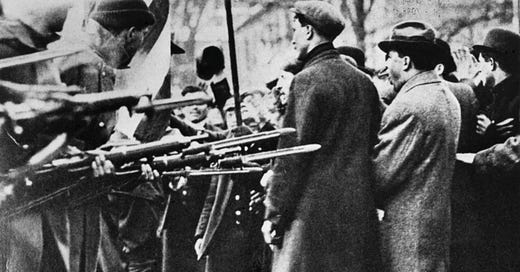Dear Moviegoers,
In 1979, the labor documentary The Wobblies was released, and subsequently, put all other films on its topic on notice. Powerful like a fist that’s worked on steel, co-directors Deborah Shaffer and Stewart Bird dropped their movie like a sack of bricks onto the cinema’s collective stage, having made what is likely the best pro-worker film of all time (all apologies to Sergei Eisenstein and Robert Greene).
Let it be that The Wobblies is a true movie of the 70s, and right at its tail end when New Hollywood was shifting to blockbuster filmmaking. It’s oh so charging to re-discover the notion of being radical when everyone else goes with the grain, and oh so enlightening to go into the past to prepare for the present and future.
The word “wobblies” refers to members of the I.W.W., the Industrial Workers of the World. Their goal was to represent and fight with all workers everywhere, not just skilled craftsmen. And by “fight,” I primarily mean picketing and “sabotage,” aka consciously lowering the efficiency of a job. Violence without being “violent.” I love it. The Wobblies covers labor striking and organizing in the early Twentieth Century, prior to and during the First World War, through interviews with the men and women who lived through it all. Decades may have passed for them, but they each speak spryly when recalling what was witnessed and what was felt. And feel, they sure did.
“What country are you a citizen of!?”
“I am a citizen of industry!”
The Wobblies achieves a depth much deeper than anything 3D filmmaking has accomplished so far, both because of its recent crisp and cleaned-up restoration (which looks impeccable) and of the resonance each story has. The now elderly workers don’t just say what happened during their struggle but accentuate what it all meant and what it all still means, primarily through anecdotes, detailed adjectives, weathered expressions, and music. It’s difficult to put into words, but seeing these older souls sing songs of resistance and solidarity that they’ve memorized by heart, to a camera crew eager to learn but who’ll never really “know,” is mesmerizing and rabble-rousing.
None of these interviews, however articulate and complete, would’ve been as impactful if it weren’t for Shaffer and Bird’s style of filmmaking. They use archival day-to-day silent footage and photographs with limited sound effects for recreation, as well as voiceover of speeches. Anti-union propaganda cartoons were found and placed throughout The Wobblies to startling effect and contrasted in this critic’s mind with the ideology of the workers themselves. I’m not afraid of the s-word “socialism,” nor am I against the progressive possibilities it represents - in fact, I consider myself a progressive. Still, some moments in the film did challenge my ideas about journalism, patriotism, communism, free speech, and so on. All or nothing? All for one and one for all of course, but… is there room for “but?” For those that saw brothers and sisters get attacked by the cops and soldiers of big business, it may have all been much simpler to understand. I’m thankful to have never experienced such atrocities.
I teared up and cried throughout The Wobblies. It may be interview after interview, but never is it redundant or boring. Never is it without action. The film moves and is always moving, in more ways than the one. Few filmmakers would dare make something like The Wobblies today, and that’s sad. Few filmmakers would dare make something like The Wobblies back then either, and it’s amazing that it exists at all. Then again, what does one expect when people aren’t treated well? 5/5
The Wobblies screens across the country on May 1st, 2022 and will be released on demand on May 31st.






